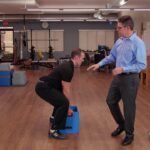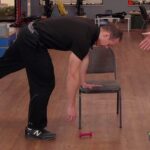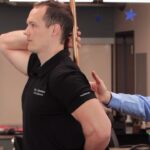Improper vs Proper Lift | Early Intervention Ergonomics
Improper Lift vs Proper Lifting Technique
What we want to demonstrate here is that this is an improper lift, and this is an improper lift for several different reasons. The first reason that I would say is with his back fully curved, he doesn’t have the opportunity to disperse the weight of what he’s getting ready to lift. We also notice that he has a significant amount of hip flexion. And his knees are also straight. Another problem is the fact that the load is too far out in front of him.
As he gets ready to lift, he’s going to be in a secondary zone, another improper lift. That we see on a regular basis is the traditional squat lift. In the traditional squat lift position, you can see that his back is now more protected because his spine is nice and straight, but he has a significant amount of bend. At both his hips and his knees, if we continue to look down just a little bit further, you’ll see that he’s up on the balls of his feet. He has no base of support and again the load is out in front of him as he’s getting ready to lift. When he comes up, he’s in the secondary zone as well.
The Stance We Like to Teach
What we like to teach is the wide stance, power lift position. In this position what you notice is that his back is nice and straight. The bend is split between both his hips and his knees with his feet staggered. The weight that he’s getting ready to lift is fully inside his base of support. As a result, both his hips, his legs and his back are doing the lifting.
Early Intervention Benefits of Proper Lifting
Using proper lifting techniques can provide several early intervention benefits, including:
- Injury Prevention: One of the primary benefits of using proper lifting techniques is the prevention of injuries. Lifting heavy objects incorrectly can lead to strains, sprains, muscle tears, and other musculoskeletal injuries. By employing proper techniques, you can reduce the risk of these injuries and maintain a healthy, pain-free body.
- Reduced Back Pain: Improper lifting is a common cause of back pain. Using the correct lifting techniques helps to minimize stress on the back muscles, discs, and ligaments, which can alleviate or prevent back pain. By distributing the load properly and engaging the larger muscles of the legs and core, you can protect your back from unnecessary strain.
- Increased Strength and Efficiency: Proper lifting techniques involve utilizing the body’s strongest muscles and maintaining good posture. By engaging the legs, hips, and core muscles, you can generate more power and lift heavier objects with greater ease. This not only increases your strength but also allows you to perform tasks more efficiently and with less fatigue.
- Improved Balance and Stability: Correct lifting techniques emphasize maintaining a stable and balanced position throughout the lift. This helps to improve your overall balance and stability, reducing the risk of falls or accidents during lifting activities. By developing better body control, you can enhance your overall coordination and stability in various daily activities.
- Enhanced Posture and Alignment: Proper lifting techniques promote proper body alignment and posture, both during the lift and in everyday life. By maintaining a neutral spine, keeping the shoulders back, and engaging the core, you can improve your overall posture. This can reduce the strain on your spine, alleviate muscle imbalances, and contribute to better overall musculoskeletal health.
- Increased Work Productivity: When you lift objects using proper techniques, you maximize your efficiency and minimize wasted effort. By utilizing the appropriate muscles and maintaining good form, you can complete tasks more quickly and effectively. This can lead to increased productivity, especially when lifting objects regularly or in physically demanding occupations.
Things to Remember
Learning and practicing proper lifting techniques can provide you with valuable skills that extend beyond lifting heavy objects. The principles of proper body mechanics, such as maintaining good posture, engaging the core, and using the legs, can be applied to various activities and movements in daily life. These skills can help you avoid injuries and perform tasks more efficiently in different contexts.
Remember, it’s always important to consider the specific requirements of the lifting task, seek assistance when needed, and listen to your body’s limits to ensure safe and effective lifting practices.
These early intervention exercises are to help reduce work-related injuries, and to improve overall health & fitness.
Contact us today for more information on how we can help you reduce work-related injuries throughout your organization.
If you have an injury or illness, consult with a health care professional before attempting.
More Tools & Resources from Peak Ergonomics
Contact Us About Reducing Workplace Injuries
Healthy Employees are the Bottom Line! – Learn More!




